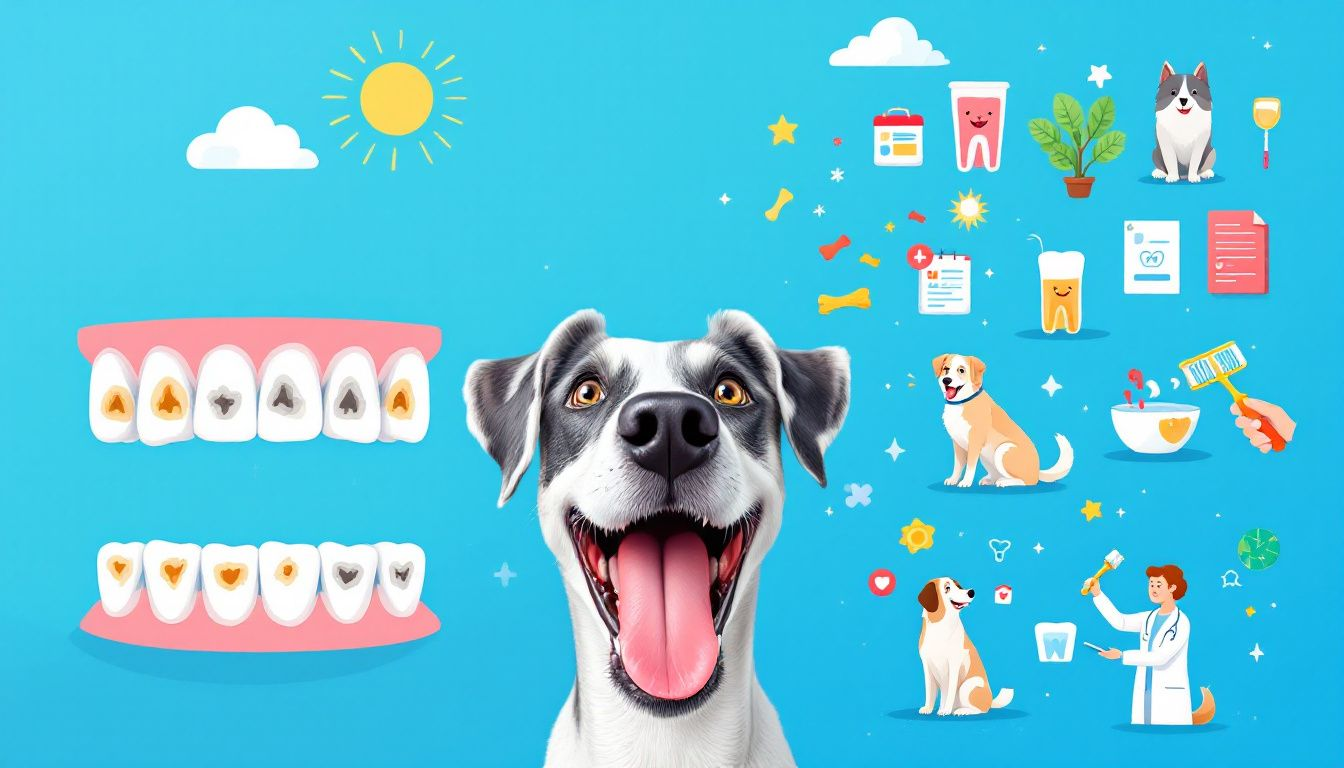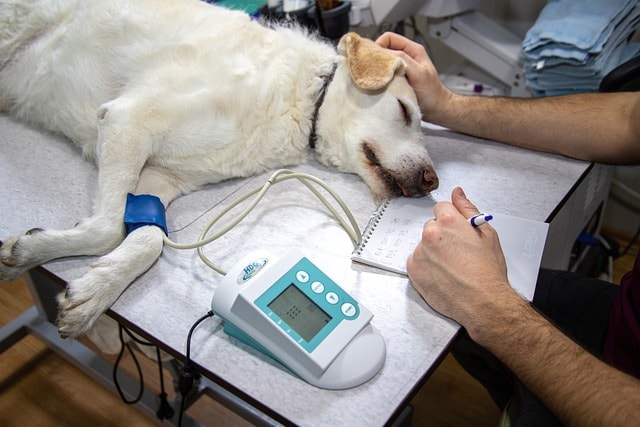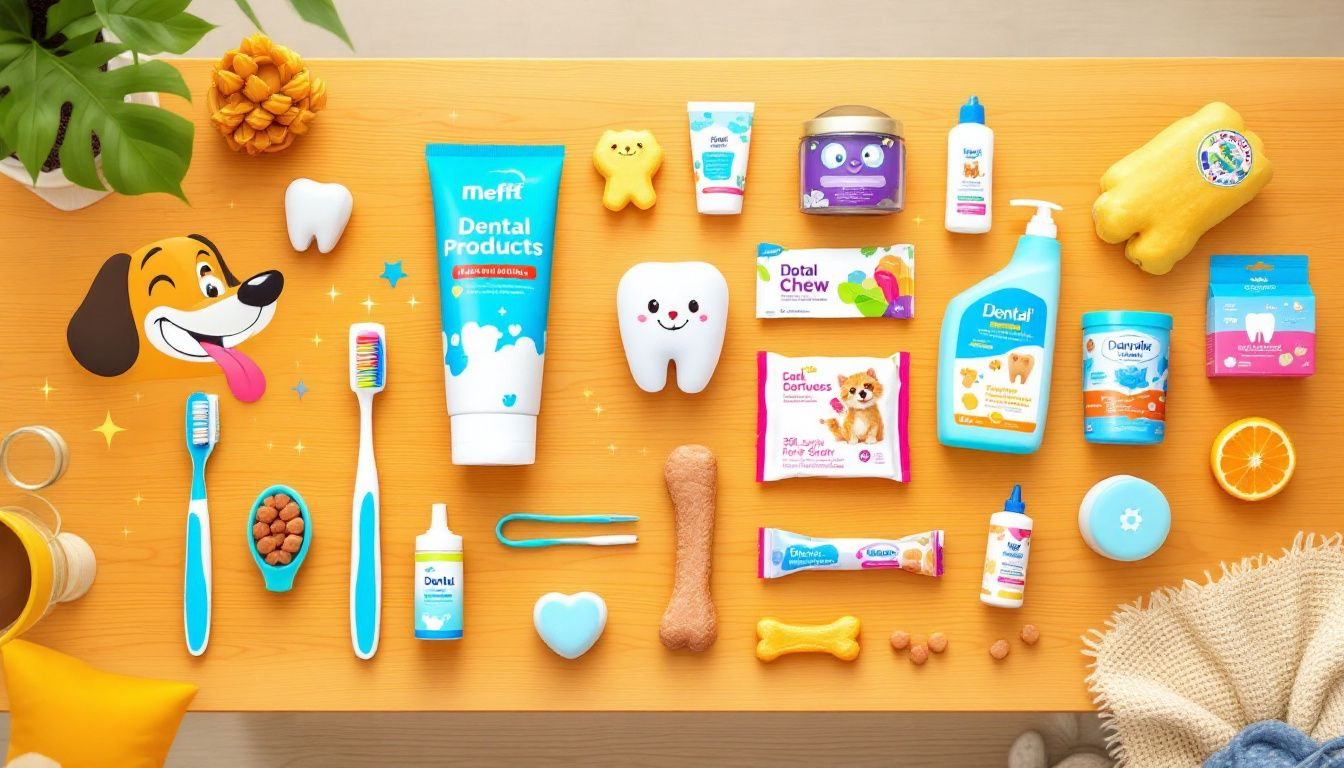Maintaining your pet’s dental health is crucial. Ignoring it can lead to painful dental diseases and severe health issues affecting the heart, kidneys, and liver. This article highlights the importance of pet dental health and offers practical advice for keeping your pet’s mouth healthy.
Key Takeaways
-
Dental disease is prevalent in pets, affecting over 80% of dogs by age three, leading to serious health consequences if untreated.
-
Recognizing early signs of dental issues, such as bad breath and behavioral changes, is crucial for timely veterinary intervention.
-
Regular professional dental cleanings under anesthesia and at-home dental care practices are essential for maintaining your pet’s oral health and preventing systemic health issues.
Understanding Dental Disease in Pets

Dental disease in pets is a common but often overlooked issue that affects pet’s teeth, gums, and supporting structures. It usually begins with dental plaque formed from food particles left between the teeth, which attract bacteria. If not removed, this plaque hardens into tartar, leading to gum inflammation and more severe periodontal issues.
Shockingly, over 80% of dogs show signs of dental disease by the age of three. Common problems include gum disease, tartar buildup, and tooth decay, all of which can cause significant pain and discomfort if left untreated. Poor dental health can also result in damage to the structures supporting the teeth, such as the jawbone, leading to tooth loss and other complications.
Ignoring dental issues in pets can have serious consequences. Bacteria from dental disease can invade under the gumline, leading to infections that can spread throughout the body. Understanding these risks underscores the importance of regular dental care to maintain your pet’s oral health and overall well-being.
Signs Your Pet May Have Dental Problems
Recognizing the signs of dental disease in pets is crucial for early intervention and treatment. Here are some early indicators to watch for:
-
Persistent bad breath, which often points to underlying dental issues.
-
Broken teeth or inflamed gums as the disease progresses.
-
Behavioral changes, such as reluctance to eat or play with chew toys, which can signal dental discomfort.
By being aware of these signs, you can take action sooner to ensure your pet’s dental health.
Many pets show no signs of dental problems until the disease is advanced. This is why regular dental exams are vital. Such check-ups can catch issues early, preventing more severe health problems and ensuring your pet’s dental health remains in check. Remember, maintaining good oral health in pets is just as important as it is for humans.
Dental disease can be especially problematic in smaller dog breeds, weakening the jaw structure and increasing fracture risks from minor accidents. Regularly monitoring your pet’s oral health and seeking veterinary care when needed can help prevent these painful and potentially dangerous outcomes.
The Impact of Poor Dental Health on Overall Health

The consequences of poor dental health extend far beyond the mouth. Bacteria from dental problems can enter the bloodstream and harm vital organs, leading to serious health issues such as heart disease, kidney disease, and liver disease. Periodontal disease, in particular, is associated with an increased risk of heart conditions, including endocarditis, especially in moderate to severe cases.
Advanced periodontal disease can cause systemic infections and damage to other body parts, including changes to the kidney, liver, and heart muscle. These severe health implications highlight the need for regular dental check-ups to identify and treat dental diseases before they worsen.
Undetected dental issues can lead to serious infections that affect a pet’s overall health. Thus, maintaining proper dental care is vital not only for preventing dental problems but also for ensuring your pet’s dental health, pet’s health, and longevity.
Professional Dental Cleaning: What to Expect

Professional dental cleaning is a key component of comprehensive pet dental care. This process typically involves general anesthesia, which allows for a thorough, tooth-by-tooth examination and ensures the procedure is safe and stress-free for your pet. Anesthesia is essential for effective treatment, allowing veterinarians to perform detailed cleanings and necessary dental procedures without causing pain or fear.
During a professional dental cleaning, veterinary technicians will scale away tartar and dental plaque from both above and below the gumline. This thorough cleaning helps to remove plaque and tartar that regular brushing might miss. If needed, additional treatments such as extractions and subgingival scaling are performed to address more severe issues.
After scaling, the teeth are polished to remove any tiny scratches and reduce future plaque buildup. Veterinarians may also recommend applying a sealer to further minimize plaque accumulation post-cleaning. Following the procedure, your pet will be monitored as they wake from anesthesia, ensuring a safe recovery.
Why Anesthesia is Necessary for Dental Procedures
Anesthesia is a critical component of veterinary dental procedures, ensuring that treatments are safe and effective. It minimizes the risk of stress, fear, and pain for pets, allowing veterinarians to conduct thorough examinations and cleanings without causing trauma. This approach improves the overall experience for pets and ensures comprehensive dental care.
Veterinary teams minimize anesthesia risks through safety measures like pre-anesthetic testing and continuous monitoring, ensuring it is administered safely and tailored to each pet’s specific needs.
Anesthesia-free dental cleanings are not recommended because they fail to provide comprehensive care and can cause unnecessary stress and trauma. Cleaning below the gumline, where many issues start, is nearly impossible without anesthesia, making it crucial for proper dental care and maintaining your pet’s oral health.
At-Home Dental Care Tips for Pet Owners

Maintaining your pet’s dental health at home is vital for preventing dental disease and ensuring a healthy mouth. Regular brushing your pet’s teeth is one of the most effective ways to reduce plaque and tartar buildup. Start by introducing tooth brushing gradually to make your pet comfortable with the process. Use pet-specific toothbrushes and toothpaste, as human products can be harmful to pets.
Consistency is key. Aim to brush your pet’s teeth 2-3 times a week for optimal dental health. Dental chews and treats also help clean your pet’s teeth mechanically, complementing regular brushing. These dental treats not only promote good oral health but also provide enjoyment for your pet.
Oral hygiene products like ProDen PlaqueOff® and Whimzee Brushzees can be particularly effective. ProDen PlaqueOff® offers powders, bites, soft chews, and dental bones designed to combat tartar and plaque. Whimzee Brushzees, approved by the Veterinary Oral Health Council, are suitable for dogs with food sensitivities. Additionally, using oral wipes and water additives can provide extra support for your pet’s dental hygiene.
Products to Help Maintain Your Pet's Oral Health

Selecting the right dental products is crucial for maintaining your pets teeth oral health. Dental chews, toys, pet-specific toothbrushes, and toothpaste are essential tools for preventing dental disease and ensuring overall well-being.
Dental chews help reduce plaque and tartar buildup while providing a satisfying chewing experience for your pet. Pet-specific toothbrushes and toothpaste effectively clean teeth without causing harm, playing a significant role in removing plaque and maintaining a healthy mouth.
Brands like ProDen PlaqueOff® and Whimzee Brushzees are excellent options. ProDen PlaqueOff® products are designed to combat tartar and plaque, while Whimzee Brushzees are suitable for dogs with food sensitivities. Consistently using these products can help keep your pet’s mouth healthy and fresh.
Summary
Maintaining your pet’s dental health is crucial for their overall well-being. By understanding dental disease, recognizing early signs, and utilizing professional and at-home dental care, you can ensure your pet leads a healthy, happy life. Regular dental check-ups, proper hygiene practices, and the right dental products all contribute to preventing dental problems and promoting good oral health.
As pet owners, it is our responsibility to provide the best care for our furry friends. By prioritizing their dental health, we can ensure they enjoy a vibrant and healthy life. Take the steps today to keep your pet’s teeth in top shape and prevent dental disease.
Frequently Asked Questions
What are the signs of dental disease in pets?
Persistent bad breath, broken teeth, inflamed gums, and changes in behavior such as reluctance to eat or engage with chew toys are clear signs of dental disease in pets. Addressing these symptoms promptly is essential for your pet's health.
How often should I brush my pet’s teeth?
To ensure your pet's dental health, you should brush their teeth 2-3 times a week. This regular care can help prevent dental issues down the line.
Why is anesthesia necessary for dental cleanings?
Anesthesia is necessary for dental cleanings to ensure a thorough and stress-free experience, allowing for detailed examinations and treatments without pain or fear for the patient. This approach helps maintain the animal's well-being during the procedure.
What are the risks of poor dental health in pets?
Poor dental health in pets significantly increases the risk of serious conditions such as heart, kidney, and liver disease, along with systemic infections. Therefore, maintaining your pet's oral hygiene is crucial for their overall well-being.
What products can help maintain my pet’s dental health?
Maintaining your pet’s dental health can be effectively achieved with dental chews, toys, and pet-specific toothbrushes and toothpaste. Brands such as ProDen PlaqueOff® and Whimzee Brushzees are especially recommended for this purpose.


